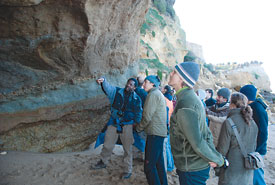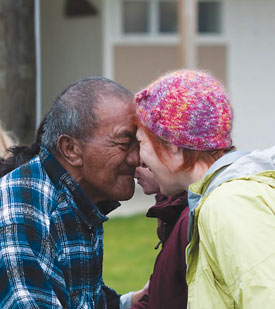First there was the cliff that crumbled and crashed onto the beach just as Ingrid Hendy was explaining to students how the natural terrace on which they were standing had formed. Then, just hours after observing the effects of past earthquakes on the landscape, the group was jostled by a magnitude 5.2 tremor.

While those real-time geology lessons weren’t on the schedule for the recent field trip to New Zealand led by Hendy and Department of Geological Sciences Chair Sam Mukasa, plenty of other, equally memorable educational experiences were. Underwritten in part by an endowment from an anonymous donor, with additional support from the International Institute, the 14-day excursion included visits to volcanoes, geothermal fields, a gold mine, a geological fault and a cave illuminated by the luminescent larvae of a species of fungus gnat.
The trip was something of a homecoming for Hendy, a sixth-generation New Zealander who grew up in the city of Hamilton. Her father Chris Hendy, an environmental geochemist at the University of Waikato, accompanied the U-M group to many of the sites on New Zealand’s North Island and shared his expertise in reconstructing past climate from geologic evidence.
The first “geology in action” experience happened at Kai Iwi Beach, as Ingrid Hendy was showing students how the coastline had changed over the past 125,000 years.
“We were looking at the rocks when we heard a boom and realized a section of the cliff farther down from where we were standing had collapsed,” she says. That night, as the group slept at a Wellington inn, the building began shaking, rousing many of the students.
After taking a ferry to the South Island, the group of 17 students, one former graduate student, the two professors and Mukasa’s 14-year-old son Chris visited the Alpine Fault, which runs almost the entire length of the island and represents a boundary between the Pacific Plate and the Indo-Australian Plate.
“There are not many places on Earth where you can actually see two plates come in contact and grind into each other,” Mukasa says.

At another stop, students got a glimpse back in time to the extinction of the dinosaurs when they viewed New Zealand’s KT boundary, a geological signature that marks the end of the Mesozoic era and the beginning of the Cenozoic era. Some 30 years ago, geologist Walter Alvarez, his father Luis Alvarez, a Nobel Prize-winning physicist, and coworkers determined that sedimentary layers found at the KT boundary throughout the world contain much higher than normal concentrations of the element iridium. Knowing that the KT boundary is associated with the mass extinction of plants and animals, including dinosaurs, about 65 million years ago, and also knowing that meteorites and asteroids have much higher iridium concentrations than Earth’s crust, the researchers proposed that the extinctions resulted when an asteroid struck Earth.
“The site we visited is one of the places the Alvarez team originally found high iridium concentrations,” Mukasa says.
Not all the trip’s lessons were geological. The group also toured sites of ecological, environmental and cultural significance, such as hydroelectric dams, an albatross breeding colony, a forest preserve where introduced pests and predators are being removed to allow native plants and animals to flourish, and a Maori Marae (sacred meeting house).
Non-Maori visitors to the Marae are allowed only by invitation and must follow protocol that includes a ritualized greeting ceremony. In days gone by, gaffes could result in massacres; today, ceremonies typically culminate in a practice known as hongi — pairs of guests and hosts touching foreheads and noses and mingling breath as a sign of unity. Still, the U-M group, wary of offending their gracious hosts, had an awkward moment when, as part of the ceremony, they were asked to sing a song of their own choosing.
“There was only one song that all of us knew, and it’s one that probably would have gotten us into trouble 150 years ago,” Mukasa says.
The selection? “Hail to the Victors.”

